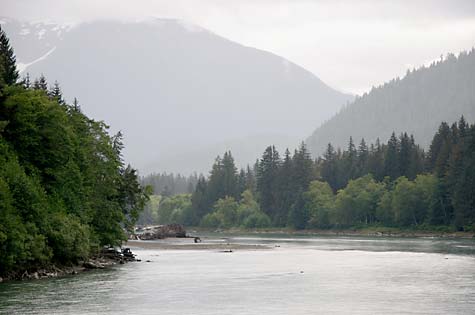Today First Nations governments and the BC government, with the support of ForestEthics Solutions, Greenpeace, Sierra Club BC and five forestry companies, announced the fulfilment of the Great Bear Rainforest Agreements.

Eighty-five percent (3.1 million hectares) of the remote wilderness region’s coastal temperate rainforests are now permanently off-limits to industrial logging. The remaining 15 percent (550,000 hectares) of the forest will be subject to the most stringent commercial logging legal standards in North America. First Nations oversight of their lands has been strengthened and new community development opportunities negotiated as a result of the government-to-government implementation process.
The fulfillment of the Great Bear Rainforest Agreements, announced within days of the launch 10 years ago, will protect biodiversity and help mitigate climate change, support improved community well-being, and provide economic certainty to the forestry sector.The success of the Agreements represents a milestone for collaboration between governments, the environmental organizations and forestry companies.
“The Great Bear Rainforest Agreements is one of the most visionary forest conservation plans on Earth,” says Valerie Langer, ForestEthics Solutions Director. “It is a principled approach that sets a new legal and science-based standard for sustaining healthy forests and maintains intact, old-growth that will keep millions of tonnes of carbon out of the atmosphere.”
“The realization of the Agreements proves their value as a model for collaboration, conservation, communities and climate action” says Jens Wieting, forest and climate campaigner for Sierra Club BC. “Implementation of the Agreements strengthens the resilience of communities and secures the ecological integrity of an ancient and vastly rich network of forests, fjords and islands twice the size of Vancouver Island.”
“Today is the culmination of 20 years of campaigning for the Great Bear Rainforest. The completion of this marathon would not have been possible without the incredible leadership of the rainforest’s First Nations leaders,” says Richard Brooks, Greenpeace’s Forest Campaign Coordinator. “From conflict to collaboration, we now celebrate the protection of areas of cultural and ecological importance while ensuring economic opportunities for the communities exist long into the future.”
After five years of intense conflict, followed by 15 years of intensive collaboration and negotiation, the new model of conservation management is informed by science, First Nations rights over their lands, and stakeholder input. The goal of this unique conservation approach is to maintain healthy forests and high levels of community well-being across the entire 6.4 million hectare Great Bear Rainforest, an area the size of Nova Scotia.
BC’s coastal old-growth rainforests store record high amounts of carbon per hectare accumulated over thousands of years and continue to sequester carbon. Increased protection of old-growth forests will result in an immediate reduction of carbon losses from logging.
The five members of the industry group that worked together with the environmental organizations as stakeholders to support the process are Interfor Corporation, Western Forest Products, BC Timber Sales, Catalyst Paper and Howe Sound Pulp and Paper. All parties involved are committed to Annual Monitoring reports and a five-year and ten-year review mechanism.
www.savethegreatbear.org






